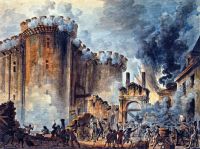Fall of the Bastille
The Fall of the Bastille occurred on July 14, 1789, while Thomas Jefferson was living in Paris and serving as American minister to France. On the evening of July 14, Jefferson was at the Hôtel de Corny when Monsieur de Corny returned home bringing an eye-witness account of the tumultuous transactions at the Bastille. Five days afterwards, Jefferson wrote about that night in a letter to John Jay; many years later, he would describe the events in his Autobiography.[1] Jefferson visited the prison twice after the event.
Primary Source References
1789 July 17. "Pd. expences to Bastille 2 [livre tournois]."[2]
1789 July 19. (Jefferson to John Jay). "The demolition of the Bastille is going on .... We cannot find with certainty that any body has been killed but the three beforementioned, and those who fell in the assault or defence of the Bastille. How many of the garrison were killed no body pretends to have ever heard. Of the assailants accounts vary from 6. to 600."[3]
1789 July 20. "Pd. seeing Bastille 6 [livre tournois]."[4]
1789 August 21. "Gave for widows of those who were killed in taking the Bastille 60 [livre tournois]."[5]
1821 January 6. (Autobiography). "[T]hey found a great collection of people already before the place, and they immediately planted a flag of truce, which was answered by a like flag hoisted on the Parapet. the deputation prevailed on the people to fall back a little, advanced themselves to make their demand of the Governor, and in that instant a discharge from the Bastille killed four persons, of those nearest to the deputies. the deputies retired. I happed to be at the house of M. de Corny when he returned to it, and recieved from him a narrative of these transactions. on the retirement of the deputies, the people rushed forward, & almost in an instant were in possession of a fortification, defended by 100. men, of infinite strength, which in other times had stood several regular sieges, and had never been taken. how they forced their entrance has never been explained. they took all the arms, discharged the prisoners, and such of the garrison as were not killed in the first moment of fury, carried the Governor and Lt Governor to the Place de Grive (the place of public execution) cut off their heads, and sent them thro' the city in triumph to the Palais royal."[6]
Further Sources
- Malone, Jefferson, 2:226.
References
- ^ Jefferson to Jay, July 19, 1789, in PTJ, 15:284-91 (transcription available at Founders Online); Jefferson, "Autobiography," January 6-July 29, 1821, Thomas Jefferson Papers, Library of Congress (transcription available at Founders Online).
- ^ MB, 1:738. Transcription available at Founders Online.
- ^ PTJ, 15:290. Transcription available at Founders Online.
- ^ MB, 1:738, 1:738n70. Transcription and editorial note available at Founders Online.
- ^ MB, 1:740. Transcription available at Founders Online.
- ^ Jefferson, "Autobiography," January 6-July 29, 1821, Thomas Jefferson Papers, Library of Congress. Transcription available at Founders Online.
